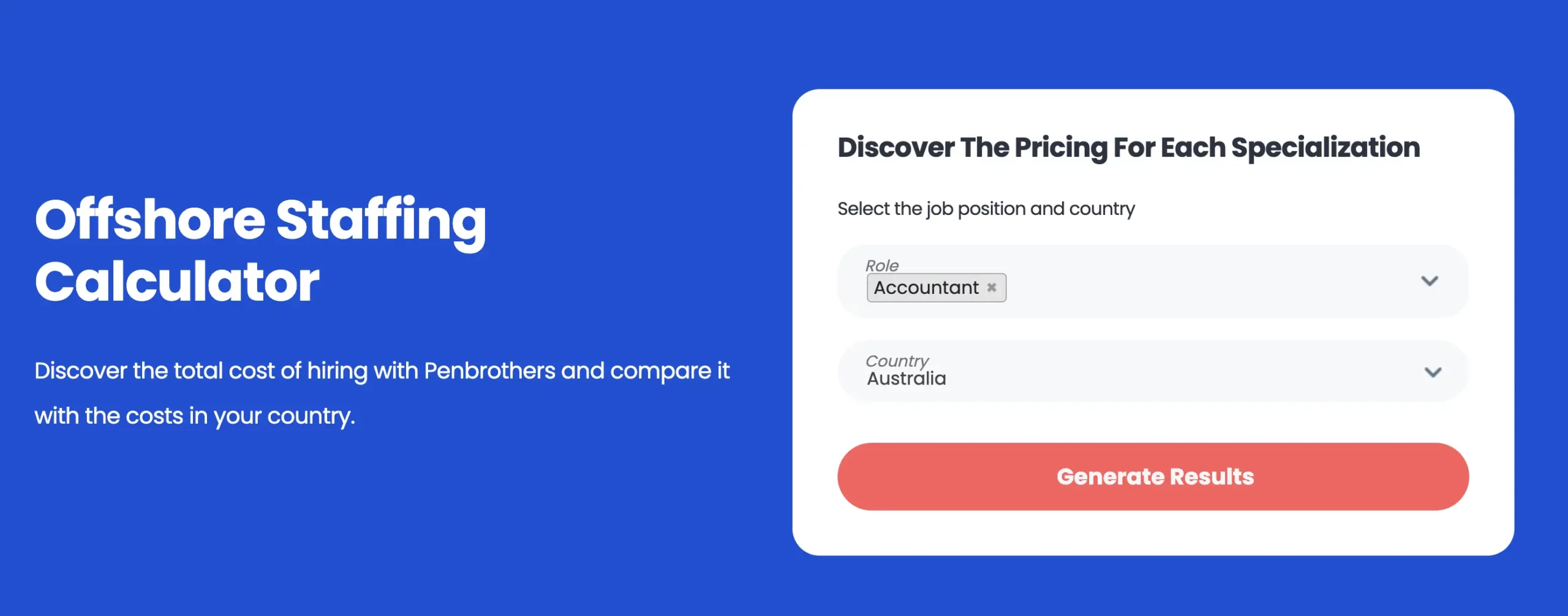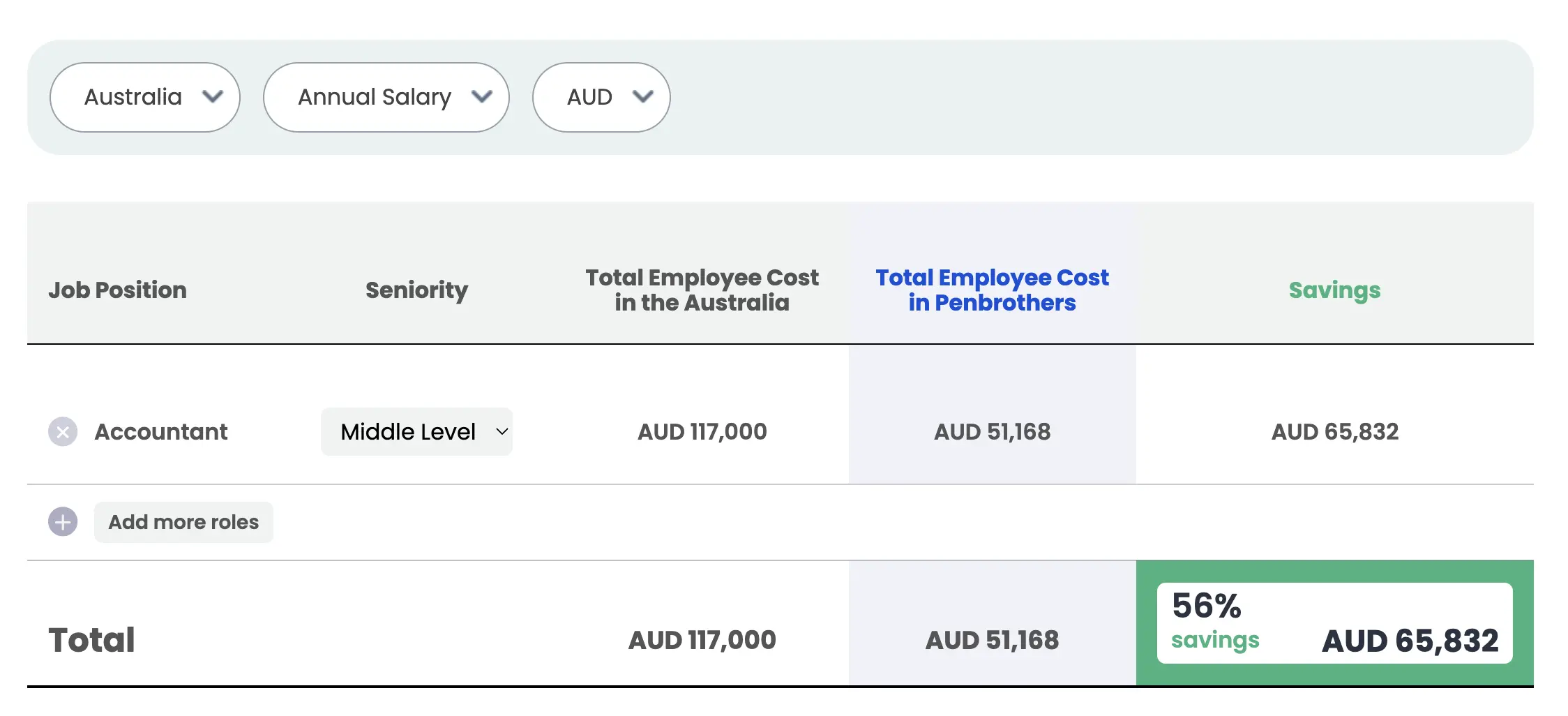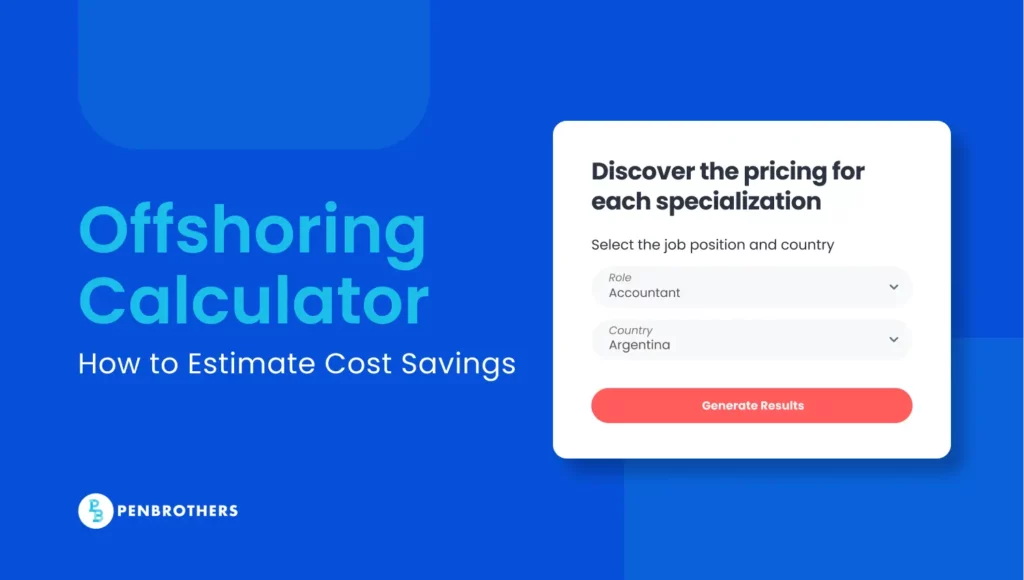One of the regular expenses that a business has to account for is the cost of not only finding but also keeping an employee. The same applies when you’re hiring an offshore worker.
To help you with making a decision on hiring staff, an offshore employee cost calculator can crunch the numbers for you.
In this article, you’ll learn more about what an offshore employee payment calculator is and how to use it to make better hiring decisions.
Key Takeaways
- A Tool for Strategic Financial Planning, Not Just a Simple Calculation: An offshore employee cost calculator is a strategic tool that allows businesses to move beyond guesswork. It enables accurate cost forecasting for international hires, which is essential for managing cash flow and making informed, data-driven decisions.
- It Calculates the Total Labor Cost, Not Just the Base Salary: A crucial function of this tool is that it computes the total labor cost, which includes not only the employee’s gross pay but also all additional costs. These can include mandatory benefits, perks, and any administrative or management fees from an offshore staffing partner.
- Provides a Clear Comparison of Cost Savings: The primary and most direct benefit of using the calculator is that it provides a clear comparison between the cost of hiring an employee locally and the cost of hiring for the same role offshore in a location like the Philippines. This allows businesses to see the potential for significant and quantifiable savings.
- Promotes Transparency and Ensures Compliance: Using a reputable calculator offers transparency into the full cost structure of an offshore hire. It helps employers understand the breakdown of payments, which in turn helps ensure that their offshore partner is compliant with local labor laws and that employees are being compensated fairly.
What are the Total Labor Costs of Hiring an Employee?
The purpose of using the cost of hiring an employee calculator is to determine the expected costs of hiring and retaining an employee. In this case, the calculators compute the total labor costs of hiring an employee.
If you want to know the computation of the total labor cost, know that many of the salary cost calculators out there generate results by looking into these factors:
- Gross Pay
- Net Hours Worked Per Year
- Additional Employee Costs
In general, though, the average hiring cost is around USD 4,700 per employee, according to the Society for Human Resource Management (SHRM). However, Edie Goldberg, founder of Menlo Park, mentions that hiring costs could be around three to four times whatever the salary is for the position you’re looking for.
Other Factors to Consider Regarding Employee Hiring Costs
Aside from the gross pay or salary that you give your employees, there are additional employee costs to consider when computing total labor costs.
Here are a few examples of these additional expenses:
📌 Employee Benefits and Perks
There is strong competition for high-value candidates these days. Employee benefits and perks that you offer can make or break a candidate’s decision to join your company.
Some of the most in-demand employee benefits that you can offer are the following:
- Retirement savings
- Health insurance
- Flexible work arrangements
- Paid time off
- Physical and mental health wellness programs
Of course, getting these benefits for your employees can cost you money, so they should be part of your total cost computation when using an employee calculator.
📌 Demand for the Role
Some job roles are more in demand now than they were a few years ago. Therefore, also consider the fluctuations of the demand for a role to see how much it will cost you to hire an employee.
For example, one of the offshoring trends is an increase in demand for knowledge process outsourcing (KPO). This can influence hiring tendencies and job role costs in that industry.
📌 Location of Employees
Hiring an offshore employee versus hiring locally can make a world of difference in terms of calculating labor costs. However, that doesn’t necessarily mean a reduction in work quality of any sort if you have the right talent acquisition strategies in place. This is why a lot of companies are hiring offshore employees from places like the Philippines.
📌 Your Business Location
Another factor that can drive employee costs up or down is your business location, as that can affect things like average wages, taxes, and so on. Even when you’re in the same country, tax rules can differ by state or locality. For example, employer costs for compensating employees can differ per region in the US.
What is an Offshore Employee Total Cost Calculator?
Computing the total cost of hiring an employee is complicated. However, one way to simplify that is with the help of a fully loaded employee cost calculator. Better yet, if you are weighing between hiring locally vs. hiring abroad, you can also use an offshore staffing calculator.
You can find a cost of employment calculator anywhere on the internet. But with an offshore employee cost calculator, you’ll get an estimate of how much it could cost your company to hire an offshore employee.
While both can estimate employee costs, an employee cost calculator specifically examines the hiring costs of an employee in your locality. On the other hand, an offshore employee calculator estimates the cost of hiring an employee from overseas, including other benefits. It may also include the management fees when you work with an offshore staffing company.
Why Should You Use a Total Employment Cost Calculator?
You might wonder why you should use this calculator in the first place. Well, here are a couple of compelling reasons to try it out.
✅ Stay Compliant While Paying Employees Right
A responsible employer wants to make cost-effective hiring decisions without compromising on the quality of the employees they provide. A reputable offshore staffing company should be able to manage your hiring practices in the country of your choosing and ensure that you are compliant with the labor laws there.
By using a hiring cost calculator, you can find out how much your offshore employee is taking home as well as how much your offshore staffing agency or employer of record (EOR) is getting from the transaction.
✅ Accurate Cost Forecasting
Assuming the cost of hiring decisions without data to back you up can lead to unexpected expenses and inaccurate cost forecasting.
When you’re able to create accurate expense forecasts, it’s easier to manage your business’s cash flow. It’s also a way to measure the benefits that a hiring decision has given your company compared to the expenses involved in making it.
How to Use Penbrothers’ Offshore Staffing Calculator

Penbrothers has an offshore staffing calculator that can quickly compute the total cost of hiring an offshore employee in the Philippines. The results also compare the cost to what you would pay to hire someone with the same job specialization in your home country, based on your location.
Here’s how to use it:
1. Select the job specialization you’re looking to hire or the closest one to it. You can even add more than one job specialization at a time.
2. Choose the country where your business is based. For this example, we’ll calculate true cost of hiring an employee in Australia.
3. Click the Generate Results button, and it will automatically calculate the employee cost.
4. A tabulated result should show you the Total Employee Cost of hiring for your chosen role in the country you’re from versus the cost of hiring an offshore employee in the Philippines.
The dropdown buttons above the tabulated results allow you to modify the view of the table. For example, instead of the annual salary, you can change it to a monthly salary view.
Most importantly, you can view the estimated cost savings you gain should you choose to hire an offshore employee with Penbrothers.
How You Can Make the Most Out of Penbrothers’ Offshore Staffing Calculator
By now, you know how the offshore staffing calculator works and how to use it. But, how can you create better and more efficient hiring decisions using this cost-of-employee calculator?
Since the Philippines is one of the best places to hire exceptional offshore staff, it has probably been on your radar if you’ve been searching for candidates to fill an open role. You can use the calculator to compare the costs of hiring locally vs. hiring offshore staff in the Philippines.
You can even compare costs based on seniority level under the Seniority column in the tabulated results. If you’re interested in hiring for roles within multiple levels, you can change the Seniority setting to check hiring costs for different hierarchies.

You can use the results to make informed hiring decisions. At the same time, the insights from the results are a great way to forecast staffing costs if your company is planning on hiring multiple roles.
While this offshore employee labor cost calculator is useful, do note that not all roles or even countries are available in the dropdown options. If this is the case for you, don’t hesitate to reach out to Penbrothers, so you can get results customized to your talent needs.
Using an offshoring salary calculator, you can get the data you need, so you will know whether hiring an onshore employee is a worthwhile decision compared to hiring abroad.
Next time you need to fill open roles, consider using the offshore staffing calculator to help you figure out the best hiring strategy for your company.
Frequently Asked Questions
It is a tool designed to estimate the total labor cost of hiring an employee who will work for your company from an overseas location, such as the Philippines. It typically compares this estimated cost to the expense of hiring for the same role in your home country.
The total labor cost includes much more than just the base salary. It also accounts for all additional employee costs, which can include health insurance, retirement plans, paid time off, other legally mandated or discretionary benefits, and any administrative fees from a third-party hiring partner.
The main benefit is accurate cost forecasting. It replaces assumptions about hiring costs with data-backed estimates. This helps businesses manage their cash flow more effectively, make smarter long-term hiring decisions, and accurately measure the return on investment of building an offshore team.
A standard employee cost calculator typically focuses on the costs associated with hiring a local employee in your own country. An offshore employee cost calculator is specifically designed to estimate the costs of hiring an employee from an overseas location and often includes factors unique to international hiring, such as management fees for an Employer of Record (EOR).
Yes. A good offshore staffing calculator allows you to customize the calculation based on the seniority level of the role you are looking to fill. This provides more granular and accurate cost estimates for junior, mid-level, or senior positions, allowing for better financial planning.





